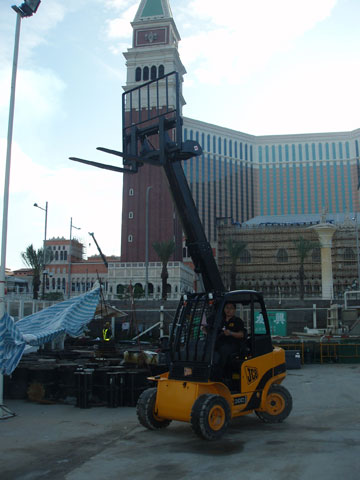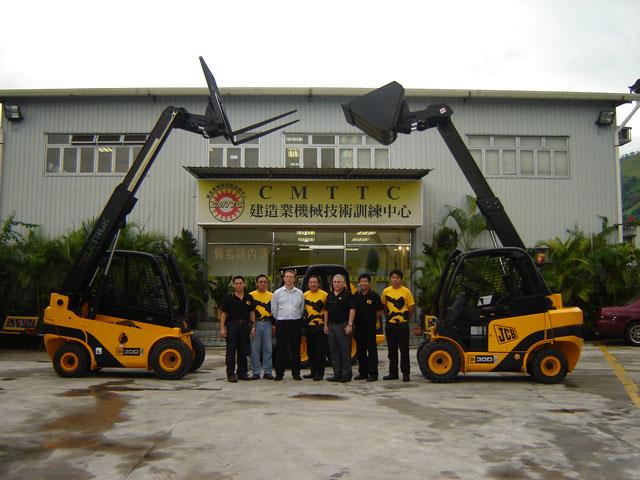 The Teletruk working at City of Dreams |
Sun Shing, JCB's new industrial equipment dealer in Hong Kong, is off to a flying start after receiving a telescopic forklift order before the first shipment of machines had arrived.
Sun Shing sales manager Man Wong sold the TLT 30D 4X4 four-wheel drive teletruk to the new City of Dreams casino complex being constructed in Macau after showing a brochure to the customer.
Three JCB Teletruks in total were shipped to Hong Kong harbour from JCB Compact Products in Cheadle, UK, this month.
A JCB employee who declined to be named because of company policy told
Forkliftaction.com News the JCB Teletruk is a unique machine. Although the teletruk has a telescopic boom, it is nothing like a telescopic handler.
He says in 1977 JCB introduced its first telehandler, the JCB 520 with two-wheel drive design. The next generation machines were designed as four-wheel drive.
But in the mid-1990s, JCB chairman Sir Anthony Bamford wanted the company to enter the industrial handling market. In January 1996, two JCB employees started investigating possibilities and considered industrial equipment like counterbalanced forklifts, access platforms and hand pallet trucks.
"Now with counterbalanced forklifts commanding such a huge world market, that was the obvious place to start," the spokesperson says.
"But the last thing we wanted to do was build a counterbalanced masted forklift like everyone else."
Research undertaken by JCB then showed there were over 40 major counterbalanced forklift manufacturers. JCB also found that the industrial load handling market required small machines with tight turning abilities and high load carrying capacities.
 Pictured at Sun Shing's training centre (L-R) Man Wong, CM Chu, Darren Brookes, WD Lam, Pete Botha, Dick Lam and Garfield Hau |
In the northern hemisphere autumn of 1997, JCB launched the JCB TLT 25D, a 2.5 tonne (5,511.6lb) capacity diesel forklift with a telescopic boom. Unlike a telehandler, the new forklift was compact, had smaller wheels, a counterweight, a smaller working footprint and a higher load capacity (2.5 tonnes to 3.5 tonnes/ 5,511.6lbs to 7,716.2lbs).
The two-wheel drive TLT 30D will lift 3,000kg (6,613.9lbs) to 5,159mm (16.9 feet), the two-wheel drive TLT 35D will lift 3,500kg (7,716.2lbs) to 4,400mm (14.4 feet) and the four-wheel drive TLT 35D 4X4 will lift 2,750kg (6,602.7lbs) to 4,350mm (14.3 feet).
"Because no such machine exists beyond ours, we decided to differentiate the concept from the conventional forklift.
"We invented a new category -TLT- the telescopic lift truck.
"The JCB teletruk range of diesel, LPG, and both two-wheel drive and four-wheel drive models is today the world's only TLT," the spokesperson says.
A decade on, JCB continues seeking out the market sectors that will benefit most from its concept forklift. Used mostly outdoors, the Teletruk can load a lorry from one side only. The absence of a vertical mast means an unblocked forwards vision for the operator. No mast, chains or rollers mean Teletruks can get right up to a pile of sand, aggregates or waste paper on a recycling station with low risk of damage. It is also quick and easy to change the Teletruk's attachments, particularly between forks and a shovel.
"The sector we have had the most success in is what we call builders' merchants - supplying bricks, building materials, sand and aggregates. The other world growth is in recycling."
The Teletruk will never replace a conventional masted forklift but will be used in market segments closed to an industrial forklift dealer, the spokesperson says.
UK legislation requires all machines used in mining operations to have roll-over-protection (ROPS) and falling-object-protection (FOPS) cabs. ROPs regulations govern the degree to which the cab's structure deforms in the event of the machine rolling over. FOPs regulations govern the amount to which a cab roof structure will deform into the inner space occupied by the operator.
All industrial masted forklifts conform to FOPs regulations but none are required to have ROPs. A teletruk has no mast and therefore its cab structure conforms to ROPs and FOPs regulations.
The UK, France, Italy and the USA are JCB's largest markets for the Teletruk.
Common applications for Teletruk
- One-side lorry loading
- Reaching from quayside for ships' store and passenger baggage handling
- Working on rough surface, semi off-road conditions with four-wheel drive
- Changing attachments quickly for landscape suppliers, builders' merchants and recycling.
- Reaching over obstructions, saving time in congested yards
- Utility companies and factories required to deliver valves and motors for maintenance work
- Rail freight
- Container work with difficult loads requiring good forwards visibility